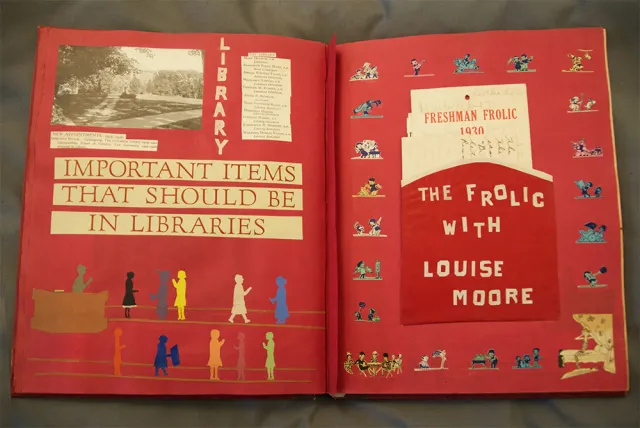Capturing Campus Memories: Student Scrapbooks Offer a Window on Decades of Life at Smith
Research & Inquiry

Published January 12, 2016
Even with her back turned, College Archivist Nanci Young can tell when students and scholars exploring the collection have reached a particular page in a scrapbook made by Gertrude Gane of the class of 1894.
“I hear the gasps,” Young says—meaning researchers have discovered the tiny capon legs that Gane saved from a wedding meal and sewed onto a page of her scrapbook.
Gane’s keepsake is one of many surprises to be found in the 350 student scrapbooks housed in the College Archives. As individual as the women who created them, the books capture student experiences from more than a century of Smith history. The earliest scrapbook in the collection dates from 1881, while the most recent is from 2006.
Young says collecting scrapbooks is part of the College Archives’ mission to document all aspects of life on campus. The archives also includes other materials created by students, faculty and staff: Letters and diaries, administrative records, biographical accounts, files on campus buildings and landscaping, and academic papers and course notes.
The earliest student scrapbooks were modified ledger books designed to hold newspaper clippings or quotes, Young says.
“From there, you start to see the inclusion of things like theatrical programs and original drawings, party favors, calling cards,” she says. “Scrapbooks become a way to create and document memories.”
Among the memories: holiday dances, hiking trips, commencement and Ivy Day speeches, study abroad, class assignments, first jobs and first loves.
The books are full of both formal and personal touches.
Fronia Fisher of the class of 1913 affixed the soles of her ballet shoes to a page in her scrapbook.
Helen Davis of the class of 1919 illustrated her book with original watercolor drawings, including one titled “my sophomore faculty garden” that portrays each of her professors as a different flower.
Harriette Gould ’41 included her acceptance letter to Smith and a student handbook in her scrapbook, along with a page of instructions for an absentee ballot under the caption, “Today I Am a Voter.”
The scrapbooks offer a window on student life that can’t be found in official college records, Young says, as well as a glimpse of Smith traditions—such as Float Day on Paradise Pond—that no longer exist.
The personal keepsakes also track larger social and cultural trends, including changes in the tools women use to document their lives.
As photography became popular in the 1890s, Young says, scrapbook-makers began to include photographic images along with traditional paper materials in their books.
In recent decades, alumnae have donated digital scrapbooks of their time at Smith recorded on DVDs and CDs.
Enthusiasm for scrapbooking has ebbed and flowed over the decades, Young says, noting that “we have good samplings of scrapbooks from the 1940s and 1950s in the archives, but the 1960s and ‘70s are not as well represented.”
Preserving the older scrapbooks is another challenge, Young says. The deteriorating ballet slippers and groaning spine of Fronia Fisher’s book are examples of what can happen to the keepsake volumes over time.
Still, Young says, it’s important for students and scholars to be able to put their hands on the materials in the collection.
“There’s something about experiencing these items first-hand,” she adds. “It gives you that sense of discovery.”
The College Archives is planning to digitize three scrapbooks made by Elizabeth Crocker Lawrence—a member of the class of 1883 for whom Lawrence House is named—as part of its contribution to the College Women project. The pilot project, funded by the National Endowment for the Humanities, supports the creation of a searchable collection from the archives of a select group of women’s colleges known as the Seven Sisters.
Are the chicken legs in Gane’s scrapbook the most unusual item visitors will encounter in the College Archives at Smith?
Young isn’t giving anything away.
“You just never know what you’ll find,” she says.

A page from a scrapbook by Helen Davis of the class of 1919 where she describes attending an election night rally and hearing political speakers. “Awfully clever!” she writes.

A page from a scrapbook in the College Archives created by Dorothea Bolton '30 during her time at Smith.

Fronia Fisher of the class of 1913 documented her 1911 performance in Rudeus of Plautus at Smith by including her ballet shoes, play programs and photos in her scrapbook.
A page from a scrapbook in the College Archives created by Fronia Fisher ’13 during her time at Smith. Photo by Carmen Pullella '16.